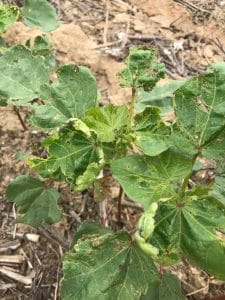As seen in previous news.utcrops.com blog articles both insects and weather are impacting cotton (Crunch Time for Cotton Insects and Cotton response to saturated soils in West TN), and this article discusses the diseases (fungal, bacterial, and viral pathogens) that may also be impacting cotton.
Foliar Leaf Spots
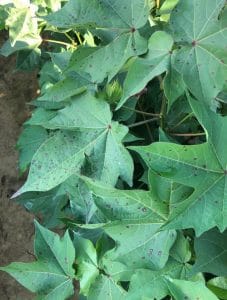
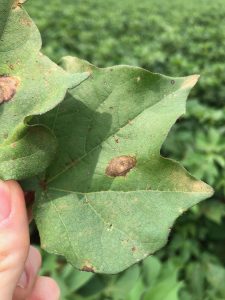
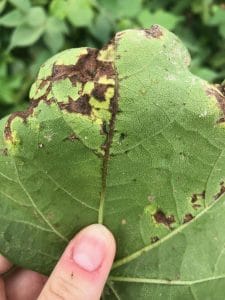
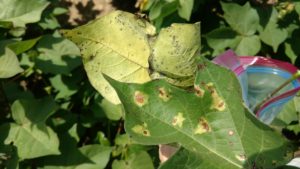
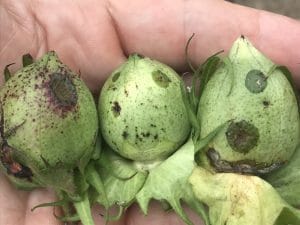
Fungal pathogens – The usual foliar spotting has been seen: leaf spot complex (stemphyllium, Cercospora, and Alternaria) – image 1, and target spot – image 2. While the leaf spot complex is usually associated with nutrient deficiency or other stressor, it will not respond to a foliar fungicide. On the other hand, target spot can require a foliar fungicide to reduce defoliation and protect yield. The main way to know the difference between the 2 leaf spots are where they are located in the field and canopy. Target spot lesions will start in the lower canopy in the rankest/growthiest cotton areas – usually only effecting high yielding cotton. Leaf spot complex lesions will be throughout the canopy and might be concentrated in areas of the field of low potash.
Bacterial pathogen – In addition to the fungal leaf spot, bacterial blight leaf symptoms have also been reported in TN this season. Bacterial blight is caused by the bacteria Xanthomonas citri pv malvacearum and hence will not respond to a fungicide. Typical symptoms are water-soaked spots that turn black as they expand and may follow veins, as atypical symptoms may look like target spots but with yellow halos (image 3-4). Similarly, symptoms on bolls are water-soaked, sunken lesions (image 5). Defoliation may occur. Planting resistant varieties is the main management option.
See guide.utcrops.com for more images, information, and a diagnostic key to differentiating leaf spots in cotton.
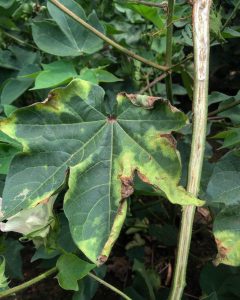
Wilts
In addition to the saturated soils causing wilts in cotton there have also been reports of verticillium wilt, caused by the soilborne fungus Verticillium dahliae. While the wilting symptoms can be seen on relatively young plants, it’s usually after flowering when most of the foliar symptoms and vascular discoloration are seen (images 6). Samples can be sent to the West TN Research and Education Center (605 Airways Blvd. Jackson, TN 38301) to confirm verticillium. Management options include using partially resistant or tolerant varieties and manipulation of cultural practices such as seeding rate, irrigation level or crop rotation.
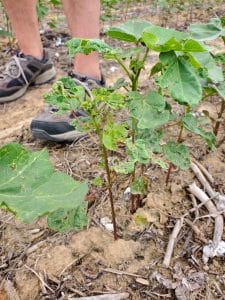
Virus
The newest pathogen in cotton is the Cotton leafroll dwarf virus (CLRDV) vectored by the cotton aphid, that can cause cotton blue disease. First reported in AL in 2017 and just recently (June 2019) found in TN, the virus is established in Brazil. Symptoms observed in the 2 fields in TN that tested positive for the virus included stunting, upward-cupped leaves, and general distorted growth/crinkled leaves (images 7-8). Although these fields have since grown out of these symptoms and one would not perceive anything to be out of the ordinary. The pathology lab at the West TN Research and Education Center is preparing to screen for the virus and aims to be able to receive samples for testing by early August – more information will be posted as the testing becomes available. More information about the virus can be found in the Auburn extension fact sheet on Cotton Blue Disease (ANR-2539). As of now, no changes in management practices are recommended.
